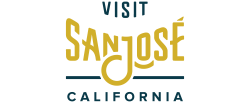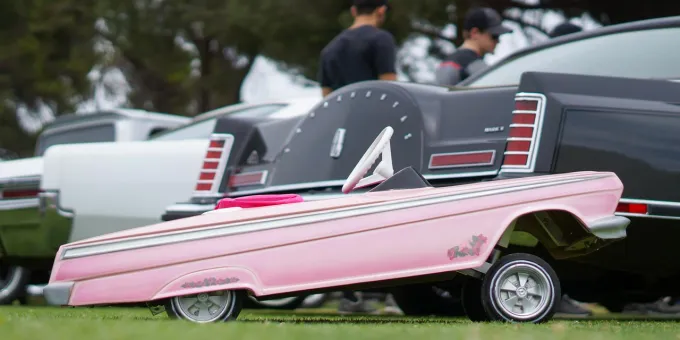To Ricardo Cortez, the streets of San Jose are once again a moving art gallery.
In 2022, the city became one of the first in the state to lift a decades-old ban on “cruising,” which seemed to outlaw certain cars associated with Chicano culture. “The ban felt like a direct message to the low rider, that you're basically not welcome,” says Cortez, a local artist also known as Tijuana Rick. Today, with the ban gone, “there's been a new embracing of lowrider culture. It feels great to tell kids that we welcome lowriders. Come over here and show off your cars."
As a Creative Ambassador of San Jose, Cortez led a local workshop where he taught kids and their families about the history of these colorful—and sometimes fender-levitating—cars. He helped his students create color bars, the pulsating light boxes that often adorn the backs of lowriders. “Color bars are the perfect example of new media artwork—they’re never the same,” he says. “Depending on the music and ambient noise, they never blink in the same pattern, and they really show the lowrider’s place in art history.”
Cortez recently chatted with Visit California about lowrider culture, and offered tips on how you can see the cars today while exploring the multicultural side of San Jose.
What are the origins of lowrider culture?
It can be traced back to 1930s and 1940s, predominantly in Los Angeles, then it spread around the country. Youth would lower their cars with heavy materials in the trunks—like cement bags, concrete blocks, and bags of rocks, to get that stance.
What was the goal?
It was a form of resistance, a form of self-expression. It's almost like a moving billboard saying, "Hey, look at me. This is how I am identifying myself through my vehicle, cruising around town in these modified cars."
How did the cars start going up and down?
After World War II, there was a surplus of airplane parts at factories and warehouses in Los Angeles. Somebody had the idea to take these hydraulic actuators from landing gears or wing flaps, modify them, and put them into the suspension of the cars. So with the flip of a switch, and some electrical wizardry and batteries, you were able to move the car up and down. Today, there are companies that sell these kits that folks can install, but it really started with these surplus parts and people just being innovative.
How did San Jose become such a hotbed for lowriders?
San Jose was the birthplace of Lowrider magazine in 1977. It came out of three students who met at San Jose State University and then produced this publication dedicated to Chicano and lowrider culture.
As a San Jose native, did you grow up experiencing this culture?
I had a friend who was into it when I was in elementary school. I went to a bilingual immersion school, and I was with kids from neighborhoods who saw low riders more than I did. This friend would bring in model cars and magazines, make them hot with motors and batteries, and he showed me how to make them my own. That planted a seed. I wasn’t born into the low-rider culture, but my parents saw that I was interested in that, and they nurtured it.
Did that interest lead you into art too?
As a young kid I was always drawing, creating, and tinkering with things—like taking apart VCRs. I thought I would be an engineer, but my brain doesn’t work that way. In college one of the counselors suggested a digital art program and after one class I was hooked.
So where can you see lowriders in San Jose today?
Social media is the best place to find out where the next event is going to be. The United Lowrider Council of San Jose's Instagram or San Jose Cruise promote a lot of local events.
Other than that, on pretty much any given good-weather Saturday or Sunday, you could probably cruise up Santa Clara Street in San Jose and you'll find some lowriders cruising around. Take Santa Clara Street all the way until it turns into Alum Rock Avenue, and you're going to see the city change its landscape from these high-rise buildings to these really cool mom-and-pop shops. You’ll also find lowriders at Roosevelt Park, right across from the Wienerschnitzel. In that parking lot, there’s a mural of a car with “San Jose” written in the same style as you see in Lowrider magazine.
How would you characterize the rest of the art scene in San Jose, and how can visitors experience it?
Like that mural, public art has become more visible here. We’ve had a lot of big blank walls become pieces of the art landscape. We’ve also seen gallery spaces become more accessible, getting different people into the art world.
1Culture, on Santa Clara Street across the street from City Hall, is a new art gallery, and they show some amazing work. You can also check out MACLA [Movimiento de Arte y Cultura Latino Americana] on First Street, which has a solid place in our community. And I would be remiss if I didn’t say the San Jose Museum of Art. I would say South 1st Street is a don’t-miss—there are a slew of art galleries there, with some bars and eateries along the way.
What are some good places to stop?
For lunch, I would go to Mark's Hot Dogs, which has been around forever. It's this orange bubble that you walk into. You order this footlong hot dog with the works, and a lot of times you'll see classic cars pull up. Another place is Peter's Bakery along Alum Rock Avenue—they have the best burnt almond cake. Get one of those and take it up to Alum Rock Park and enjoy a picnic.
What other spots in San Jose make your must-see list?
I would definitely suggest doing a little historical exploration of San Jose. A house where Cesar Chavez lived has been turned into a historical landmark. And at Kelley Park, there's an area called History Park San Jose that has 32 original homes. Some have been turned into museums, and there's everything from a trolley to an old ice cream parlor, and it's free.
Also, Santana Row is a beautiful area, the way it’s been developed. I also recommend Original Joe’s which has been there since the 1950s—it’s an Italian restaurant, and the atmosphere is very old school. And of course there’s Falafel’s Drive-In, and any of the Michelin-starred restaurants.
What do you say to people who think San Jose is mostly a tech town?
When I teach kids about lowrider history, I always say that San Jose gets looked at as the capital of Silicon Valley. Apple Computers was built in a garage in 1975 and the most famous lowriders were also built in our garages in 1975 and 1976. As technology was evolving, so was lowriding. There was this race to create personal computers, but also who could make a lowrider jump over itself.
There’s something so special and unique about this valley where you have this innovation mindset—how can you be different, push the envelope, modifying something and making it better. That worked in the car culture here too.
To hear more from Cortez and other San Jose locals, check out this episode of the California Now Podcast.

